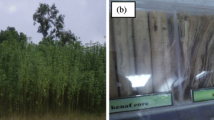Abstract
Investigation on the fatigue life of hybrid composites is critical to extend their applications and acceptance among industries; however, there is a lack of research focus on fatigue performance of the hybrid composite. In this study, the fatigue life of glass/kenaf woven-ply hybrid composite with thermoplastic and thermoset polymer matrix was investigated. Hybrid composites consist of two different fibre configurations: kenaf/glass/kenaf and glass/kenaf/glass. Thermoplastic hybrid composites were manufactured through the hot press moulding compression method, while thermoset hybrid composites were fabricated through the vacuum-assisted resin infusion method. The tensile strength and fatigue strengths of the kenaf/glass/kenaf composite have been identified to be significantly lower than those of the glass/kenaf/glass composite regardless of the types of matrix used. However, thermoplastic-based kenaf/glass/kenaf composites are less fatigue sensitive compared to glass/kenaf/glass composites; however, this phenomenon is vice versa for thermoset composites due to the epoxy matrix, which limits the stiffening effect in natural fibres.










Similar content being viewed by others
References
Dhar Malingam S, Hashim MHR, Said MR, Rivai A, Daud MA, Sivaraos, Che Mahzan MA (2015) Effect of reprocessing palm fiber composite on the mechanical properties. Appl Mech Mater 699:146–150
Bledzki AK, Faruk O, Sperber VE (2006) Cars from bio-fibres. Macromol Mater Eng 291:449–457.
Jayaraman K (2003) Manufacturing sisal-polypropylene composites with minimum fibre degradation. Compos Sci Technol 63:367–374
Karahan M, Karahan N (2015) Investigation of the tensile properties of natural and natural/synthetic hybrid fiber woven fabric composites. J Reinf Plast Compos 0(0):1–12
Kalam A, Sahari BB, Khalid YA, Wong SV (2005) Fatigue behaviour of oil palm fruit bunch fibre/epoxy and carbon fibre/epoxy composites. Compos Struct 71(1):34–44
Thomas S (2002) Hybrid composites. Biocomposites 4:315–328
Wang B, Lu H, Kim G (2002) A damage model for the fatigue life of elastomeric materials. Mech Mater 34(8):475–483
Amiri M, Khonsari MM (2010) Rapid determination of fatigue failure based on temperature evolution: fully reversed bending load. Int J Fatigue 32(2):382–389
Sharba MJ, Leman Z, Sultan MTH, Ishak MR, Hanim MAA (2016) Effects of kenaf fiber orientation on mechanical properties and fatigue life of glass/kenaf hybrid composites. BioResources 11(1):1448–1465.
Shahzad A (2011) Impact and fatigue properties of hemp-glass fiber hybrid biocomposites. J Reinf Plast Compos 30(16):1389–1398
Asgarinia S, Viriyasuthee C, Philips S, Dube M, Baets J, Vuure AV, Verpoest I, Lessard L (2015) Tension-tension fatigue behaviour of woven flax/epoxy composites. J Reinf Plast Compos 34:857–867
Mohanty AK, Misra M, Hinrichsen G (2000) Biofibers, biodegradable polymers and biocomposites. An overview. Macromol Mater Eng 276(1):1–24
Anuar H, Ahmad AH, Rasid R, Zakaria S (2005) Tensile behavior and morphological studies of TPNR-KF-CF Hybrid composite. Am J Appl Sci 5:34–39
Zainudin ES, Sapuan SM, Sulaiman S, Ahmad MMHM (2002) Fibre orientation of short fibre reinforced injection moulded thermoplastic composites: a review. J Inject. Mould. Technol. 6(1):1–10
Holbery J, Houston D (2006) Natural-fiber-reinforced polymer composites in automotive applications. J Miner Metals Mater Soc 58(11):80–86
Aktas A, Boyd SW, Shenoi RA (2012) Measurement of permeability and cure using thermocouples in the vacuum assisted resin infusion process to aid simulation. In: 15th European conference on composite materials. Venice 24–28.
Jawaid M, Abdul Khalil HPS, Abu Bakar A, Noorunnisa Khanam P (2011) Chemical resistance, void content and tensile properties of oil palm/jute fibre reinforced polymer hybrid composites. Mater Des 32:1014–1019
Liang S, Gning PB, Guillaumat LA (2012) Comparative study of fatigue behaviour of flax/epoxy and glass/epoxy composites. Compos Sci Technol 72(5):535–543
Baley C (2002) Analysis of the flax fibres tensile behaviour and analysis of the tensile stiffness increase. Compos Part A 33:939–948.
Harris B (2003) Fatigue in composite-science and technology of the fatigue response of fibre-reinforced plastics. CRC Press, Boca Raton
John S, Herszberg I, Coman F (2001) Longitudinal and transverse damage taxonomy in woven composite components. Compos Part B 32:659–668.
Nygård P, Redford K, Gustafson CG (2002) Interfacial strength in glass fibre-polypropylene composites: influence of chemical bonding and physical entanglement. Compos Interfaces 9(4):365–388
Garkhail SK, Heijenrath RWH, Peijs T (2000) Mechanical properties of natural-fibre-mat-reinforced thermoplastics based on flax fibres and polypropylene. Appl Compos Mater 7:351–372
Meng Q, Wang Z (2015) Theoretical analysis of interfacial debonding and fiber pull-out in fiber-reinforced polymer-matrix composites. Arch Appl Mech 85:745–759
Wu Z, Wang X, Iwashita K, Sasaki T, Hamaguchi Y (2010) Tensile fatigue behaviour of FRP and hybrid FRP sheets. Compos Part B 41:396–402.
Pickering KL, Aruan Efendy MG, Le TM (2016) A review of recent developments in natural fibre composites and their mechanical performance. Compos Part A 83:98–112.
Tran LQN, Yuan X, Bhattacharyya D, Fuentes CA, Van Vuure AW, Verpoest I (2015) Fiber-matrix interfacial adhesion in natural fiber composites. Int Mod Phys B 29(10): 1–7.
Shahzad A (2013) A study in physical and mechanical properties of hemp fibres. Adv Mater Sci Eng 2013:1–9
Legras A, Truss R, Chaleat C, Heitzmann MT (2015) A practical toolbox to overcome the multiple challenges of biocomposites extrusion. Composites Australia and CRC ACS 2015 Composites Conference.
Militky J, Kovacic V, Rubnerova J (2002) Influence of thermal treatment on tensile failure of basalt fibres. Eng Fract Mech 69(9):1025–1033
Acknowledgements
The authors would like to thank Universiti Teknikal Malaysia Melaka for their continuous support to this research project. The authors also wish to express their gratitude towards Lembaga Kenaf dan Tembakau Negara for the sponsorship of kenaf fibre and FRGS/1/2015/SG06/FKM/03/F00276 from the Ministry of Higher Education Malaysia.
Author information
Authors and Affiliations
Corresponding author
Ethics declarations
Conflict of interest
None.
Rights and permissions
About this article
Cite this article
Sivakumar, D., Ng, L.F., Lau, S.M. et al. Fatigue Life Behaviour of Glass/Kenaf Woven-Ply Polymer Hybrid Biocomposites. J Polym Environ 26, 499–507 (2018). https://doi.org/10.1007/s10924-017-0970-0
Published:
Issue Date:
DOI: https://doi.org/10.1007/s10924-017-0970-0




